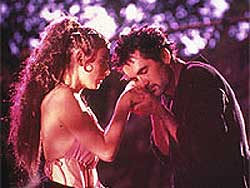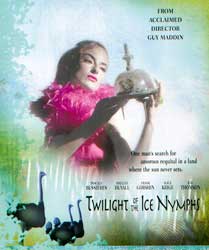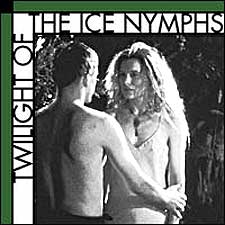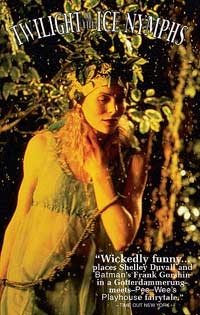I have a love-him/aggravated-by-him "relationship" with Guy Maddin, or with his films at least. On the one hand I get a real kick out of the influences he takes from the silent film era & find many of his films visually remarkable. I also regard him as authentic rather than merely artsy fartsy, like this really is the best he can do, with the influences he sincerely adores & embraces.
On the other hand he too often uses the excuse of being avant garde to tell a story (if it qualifies as a story) in terms of the symbolic, the surreal, & the nonsensical, in a way that makes no sense to anyone. And without forward plot momentum or accumulating meaning, even a short film can seem feel a long row to hoe.
 And yet when he does do something that is more or less "plotted" like a "real" meaning "commercial" film, the main thing that makes it bearable are the intrusions of Maddinist wit, symbol, & strangeness. And yet when he does do something that is more or less "plotted" like a "real" meaning "commercial" film, the main thing that makes it bearable are the intrusions of Maddinist wit, symbol, & strangeness.
Garish & eerilly off-kilter color makes Twlight of the Ice Nymphs (1997) immediately appear other-worldly, as though taking place on an alien world or within the Hollow Earth. I frankly prefer Maddin's usual use of black & white, but one has to admit his color pallet is pretty darned strange, at times almost like hand-tinted vintage postcards.
The is set in a place of long summers when the sun fails to set, no one sleeps properly, & the margin between the real & the unreal diminishes.
There are times when the heavy-handed ornamented dialogue seems to want to be Shakespeare's A Midsummer's Night's Dream. And depending on which actor is trying to make it work, it can sound like the most pathetically amateurish B-S of all time, struggling for heights of grandure & achieving depths of silliness; or from the two or three more convincing players it can sound neither pompous nor goofy but an actual part of nutty yet believable characterization.
So what fails is the fault of actors unable to save the more dreadful bits amidst scriptwriter George Toles' phony or failed poetics. And what works is thanks to Shelley Duvall, Frank Gorshin, & especially Alice Krige who each seem really to be living in a different universe where creatures might actually speak & behave in this manner.
Maddin appears to have intervened very little in his own film, letting those actors who weren't up to it fail, & refusing to weed out the script's more juvenile or misguided moments which provide the primary reason some of the actors fail.
On the good ship lollipop which does appear to be made out of taffy, at sea under the perpetual sun, a beautiful nymph, Juliana (Pascale Bussieres), appears to Peter (Nigel Whitmey), an ex-convict heading home after four years. She asks him to commit a theft for her, to obtain a necklace from a box in a certain cabin, which cabin she afterward admits was her own. They make love & she promises to see him again, & then vanishes from the ship.
 He arrives home to his sister Amelia (Shelley Duvall) & the ostrich farmer Cain Ball (Frank Gershin) who works on Amelia's property. Cain Ball strives always to convince Amelia to sign her land over to him, since she cannot run the farm herself. She has often said she might do so if & when she has an opportunity to marry & move away. When Peter returns it throws Cain Ball into a personal crisis, as the land is half Peter's, & Cain Ball had rather hoped the lad was dead. He arrives home to his sister Amelia (Shelley Duvall) & the ostrich farmer Cain Ball (Frank Gershin) who works on Amelia's property. Cain Ball strives always to convince Amelia to sign her land over to him, since she cannot run the farm herself. She has often said she might do so if & when she has an opportunity to marry & move away. When Peter returns it throws Cain Ball into a personal crisis, as the land is half Peter's, & Cain Ball had rather hoped the lad was dead.
Awakening from "sleep-hunting" (which excuses some extremely bad film editing actually), Peter is dressed like a green-man all in leaves, with his hunting dog & rifle. Thus clad he meets Zephyr (Alice Krige), a pregnant nymph whose husband the fisherman, she claims, was lost at sea, & might or might not return. She wants Peter for her lover, but he says he loves another, a woman he met only once but hopes to meet again.
Later during the endless sunlit day, Zephyr gives her wedding ring in prayer to a statue of the Goddess Aphrodite which the one-legged doctor has been restoring on a hilltop whereon the stone goddess had been found buried. As Zephyr places the ring on the statue's finger she prays that Peter will become her lover, & any rival for his love be laid low.
Peter has a nightmare of the shipboard nymph being buried alive, a stake driven through her heart. He awakens again & spots Zephyr in the pending storm & follows her until he becomes ill. Though pregnant, she easily lifts him up & carries him to her cliff wall, wherein she has him wear her clothes. They dwell in the tide before the cliff, in a state of continuous carnality.
Amelia has an unrequited crush on the one-legged Dr. Isaac Solti (R. H. Thomson). He acquired his wooden leg after an accident, or an assault, that occurred when he discovered & attempted to lift up the stone Aphrodite, which fell on him & crushed his leg.
He has a devilish personality as well as a devil's limp. He lives with the nymph Juliana. He invites Amelia & Peter on a boat ride with him & Juliana, upon which outing Amelia's small dreams of happiness with the cruel doctor are dashed.
 During the boat ride, picnic, & later the tour of the doctor's villa & collection of macabre memorabelia, Peter learns that Juliana lives under the doctor's mesmeric compulsions, & nothing she says originates in her own mind. He beats up the crippled doctor & flees the residence. Juliana follows after him, assuring Peter that her feelings are her own, though as things turn out he's quite right to continue to doubt it. During the boat ride, picnic, & later the tour of the doctor's villa & collection of macabre memorabelia, Peter learns that Juliana lives under the doctor's mesmeric compulsions, & nothing she says originates in her own mind. He beats up the crippled doctor & flees the residence. Juliana follows after him, assuring Peter that her feelings are her own, though as things turn out he's quite right to continue to doubt it.
Zephyr meanwhile strives & connives to get Peter back in her powers. She's by far the most interesting character if not because of the writing then because Zephyr is the best played role & as her strange history & doomful fate unfold, it is entirely captivating. Too bad the romance of Juliana & Peter is so boring by comparison since it takes up so much time.
Giving up her dream of the doctor, Amelia returns to the ostrich farm, where she finds broken glass strewn in her bedroom, & becomes convinced Cain Ball wants to kill her to possess her land. She thus sets out to seduce him, get him roaring drunk, then like Judith in the tent, drive a nail into the head of her perceived foe. She's lost her mind, clearly, & sets fire to the barn to destroy the evidence of her crime, but at the same time traps the hunting dog & the ostriches.
Cain Ball is not dead & with the large nail sticking out of his head, he struggles to save the animals, but can barely save himself. Frank Gershin gives this character enormous pathos despite the edge of absurdist comedy the script imposes on the role. Gershin completes his performance deeper & deeper in Cain Ball's brain-damaged hallucinations, & its a rare opportunity to see that the man really could act, & was not just a commedian.
Seeking symbolic meaning for these characters fails though it can for a while be viewed as Venus & the demon Physician interferring with the love lives & fates of fertility daemons & nymphs. As the long summer comes to a close, however, the glamor of the season likewise fades, & even the strange Dr. Solti is just a doctor with a wooden leg, Juliana perhaps after all only the daughter of a prostitute by the ejaculate of a hanged man, Zephyr a murderess, & Amelia a madwoman cared for by her brother. Yet who is to say what counter-glamour will fall upon them during the pending long night.
Throughout, Nigel Whitmey has proven to be a wooden actor who has a difficult time "selling" the often ridiculous dialogue. He very nearly ruins the experience of the film. The character of Peter is central to the tale but Whitmey alas is either untalented or just couldn't buy the role himself; so not believing in such absurdity, he could not play it as real.
But Alice Krige, best known for having played the Borg Queen, delivers an intense femme fatale performance with shocking conviction & sex appeal. Duvall & Gorshin also turn in performances of merit, rendering credible even the silliest of lines.
The remaining cast as Juliana & the one-legged doctor are adequate to the task, but the character of Juliana has so many lines it's unfortunate she wasn't a little closer to Duvall & Krige in actorly ability. As played I never believed anyone given a choice between Zephyr & Juliana would select a dufus like Juliana.
Apart from this significant weakness, Twilight of the Ice Nymphs is one of Guy Maddins more accessible films. He usually doesn't even care if his films make sense as long as they're visually exciting. This one's not as visually novel as most of his work, but the story is ninety percent comprehensible as an adult fairy tale.
The casting of Shelley Duvall heightens the effect of this being a "normal" fairy tale like those which she produced for the brilliant Fairy Tale Theater (1982-1987). But of course Maddin cannot make anything quite that comprehensible & any viewer attempting to make perfect sense of the events of Twlight of the Ice Nymphs will find the occupation harrowing.
'm a mite fearful the film is too close to "regular" to pass muster for its sometimes ridiculous dialogue that has mistaken redundancies for purple prose, & some of the wacky editing & of course that awful performance by Nigel Whitmey. The one film of Maddin's most like Twlight is Archangel (1990) but which is stylistically so extreme that even flaws become part of the texture of the movie, so Archangel becomes, in its own bent way, flawless. By moving closer to Hollywood norms with Twilight Maddin too much reveals rather than disguises his limitations as a filmmaker.
copyright © by Paghat the Ratgirl
|

 And yet when he does do something that is more or less "plotted" like a "real" meaning "commercial" film, the main thing that makes it bearable are the intrusions of Maddinist wit, symbol, & strangeness.
And yet when he does do something that is more or less "plotted" like a "real" meaning "commercial" film, the main thing that makes it bearable are the intrusions of Maddinist wit, symbol, & strangeness. He arrives home to his sister Amelia (Shelley Duvall) & the ostrich farmer Cain Ball (Frank Gershin) who works on Amelia's property. Cain Ball strives always to convince Amelia to sign her land over to him, since she cannot run the farm herself. She has often said she might do so if & when she has an opportunity to marry & move away. When Peter returns it throws Cain Ball into a personal crisis, as the land is half Peter's, & Cain Ball had rather hoped the lad was dead.
He arrives home to his sister Amelia (Shelley Duvall) & the ostrich farmer Cain Ball (Frank Gershin) who works on Amelia's property. Cain Ball strives always to convince Amelia to sign her land over to him, since she cannot run the farm herself. She has often said she might do so if & when she has an opportunity to marry & move away. When Peter returns it throws Cain Ball into a personal crisis, as the land is half Peter's, & Cain Ball had rather hoped the lad was dead. During the boat ride, picnic, & later the tour of the doctor's villa & collection of macabre memorabelia, Peter learns that Juliana lives under the doctor's mesmeric compulsions, & nothing she says originates in her own mind. He beats up the crippled doctor & flees the residence. Juliana follows after him, assuring Peter that her feelings are her own, though as things turn out he's quite right to continue to doubt it.
During the boat ride, picnic, & later the tour of the doctor's villa & collection of macabre memorabelia, Peter learns that Juliana lives under the doctor's mesmeric compulsions, & nothing she says originates in her own mind. He beats up the crippled doctor & flees the residence. Juliana follows after him, assuring Peter that her feelings are her own, though as things turn out he's quite right to continue to doubt it.